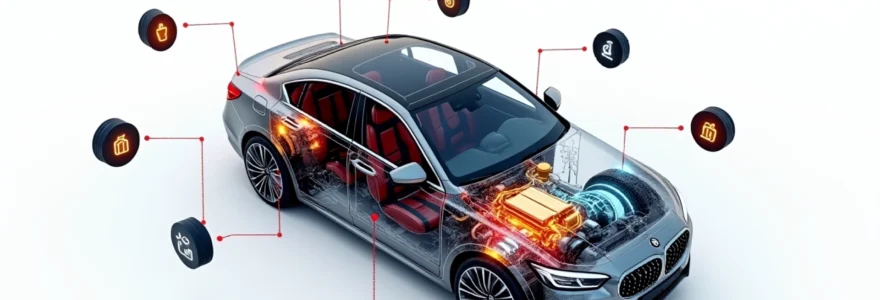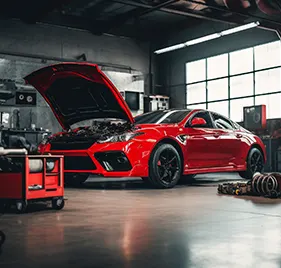Regular car maintenance is the key to ensuring your vehicle runs efficiently, safely, and reliably for years to come. By following a few essential maintenance tips, you can prevent costly repairs, improve fuel economy, and extend the life of your car. Let's explore the crucial aspects of vehicle upkeep that every car owner should know to keep their automobile in top condition.
Regular oil changes protect your engine
One of the most critical aspects of car maintenance is regular oil changes. Engine oil lubricates moving parts, reduces friction, and helps dissipate heat. Over time, oil breaks down and becomes contaminated, losing its effectiveness. Neglecting oil changes can lead to engine damage and decreased performance.
Check oil level monthly
To maintain optimal engine health, check your oil level at least once a month. Park your car on level ground, wait for the engine to cool, and use the dipstick to verify the oil level. If it's below the minimum mark, add the appropriate amount of oil to reach the correct level.
Use manufacturer recommended oil type
Always use the oil type and viscosity recommended by your car's manufacturer. Modern engines are designed to work with specific oil formulations, and using the wrong type can affect performance and fuel efficiency. Consult your owner's manual or ask a professional mechanic for guidance.
Replace oil filter each change
When changing your oil, always replace the oil filter as well. The filter removes contaminants from the oil, and a clogged filter can reduce oil flow, potentially damaging your engine. Using a new filter with each oil change ensures optimal filtration and engine protection.
Tire pressure impacts fuel economy safety
Proper tire maintenance is crucial for both safety and fuel efficiency. Underinflated tires can reduce fuel economy, increase wear, and compromise handling. On the other hand, overinflated tires can lead to a harsh ride and uneven tread wear.
Check tire pressure weekly
Make it a habit to check your tire pressure weekly, especially before long trips. Use a reliable tire pressure gauge and measure when the tires are cold for the most accurate readings. Compare the readings to the recommended pressure listed in your owner's manual or on the driver's side door jamb.
Properly inflate underinflated tires
If you find your tires are underinflated, add air until they reach the recommended pressure. Be careful not to overinflate, as this can be just as problematic as underinflation. Remember that tire pressure can fluctuate with temperature changes, so regular checks are essential.
Rotate tires every 5,000 miles
Tire rotation helps ensure even wear across all four tires, extending their lifespan and maintaining consistent handling. Most manufacturers recommend rotating tires every 5,000 to 8,000 miles. Consult your owner's manual for the specific rotation pattern recommended for your vehicle.
Brake maintenance ensures reliable stopping power
Your car's braking system is critical for safety, and regular maintenance is essential to ensure optimal performance. Neglecting brake maintenance can lead to reduced stopping power, increased wear on components, and potentially dangerous situations on the road.
Listen for any unusual noises when braking, such as squealing or grinding, which may indicate worn brake pads. Also, pay attention to how your brake pedal feels. If it feels spongy or requires more pressure than usual, it's time for a brake inspection.
Have your brakes inspected by a professional at least once a year or every 12,000 miles. During this inspection, a mechanic will check brake pad thickness, rotor condition, and brake fluid levels. They may also recommend replacing worn components or performing a brake fluid flush if necessary.
Coolant flushes prevent overheating corrosion
Your car's cooling system plays a crucial role in preventing engine overheating and protecting internal components from corrosion. Regular maintenance of this system is vital for long-term engine health and reliability.
Check coolant level regularly
Make it a habit to check your coolant level at least once a month. Ensure the engine is cool before opening the coolant reservoir. The level should be between the "min" and "max" lines on the reservoir. If it's low, top it off with the correct type of coolant.
Flush system per maintenance schedule
Over time, coolant breaks down and loses its protective properties. Follow your manufacturer's recommended schedule for coolant flushes, typically every 30,000 to 50,000 miles. A flush removes old coolant and contaminants, replacing them with fresh coolant for optimal protection.
Use correct coolant mixture ratio
When adding or replacing coolant, always use the correct mixture ratio of antifreeze to water, usually 50/50. Using the wrong ratio can lead to inadequate freeze protection or reduced cooling efficiency. Some vehicles require specific types of coolant, so consult your owner's manual before adding or replacing coolant.
Air filter replacements optimize engine performance
Your car's air filter plays a crucial role in protecting the engine from harmful debris and ensuring optimal air intake for combustion. A dirty or clogged air filter can reduce engine efficiency, decrease fuel economy, and even lead to engine damage if left unattended.
Most manufacturers recommend replacing the air filter every 15,000 to 30,000 miles, but this can vary depending on driving conditions. If you frequently drive on dusty roads or in heavy traffic, you may need to replace it more often.
Inspecting your air filter is a simple task you can do yourself. Remove the filter and hold it up to a light source. If you can't see light passing through it, it's time for a replacement. When installing a new filter, ensure it's seated properly to prevent unfiltered air from entering the engine.
Transmission fluid changes prolong component life
Transmission fluid is often overlooked in routine maintenance, but it's crucial for the smooth operation of your car's gearbox. Over time, transmission fluid breaks down and becomes contaminated, which can lead to shifting problems and premature wear of transmission components.
Check your transmission fluid level and condition regularly, following the procedure outlined in your owner's manual. Many modern cars have sealed transmissions that require special procedures for checking and changing fluid.
The frequency of transmission fluid changes varies by vehicle, but a general rule is to change it every 30,000 to 60,000 miles for manual transmissions and every 60,000 to 100,000 miles for automatic transmissions. However, always defer to your manufacturer's recommendations, as some newer vehicles may have longer intervals or even "lifetime" fluids.
Regular transmission maintenance can significantly extend the life of your vehicle's transmission, potentially saving thousands of dollars in repair costs.
Spark plug replacements restore engine efficiency
Spark plugs are essential components in gasoline engines, responsible for igniting the fuel-air mixture in the combustion chamber. Over time, spark plugs can wear out, leading to reduced fuel efficiency, poor acceleration, and rough idling.
Modern spark plugs with platinum or iridium tips can last up to 100,000 miles, but traditional copper-tipped plugs may need replacement every 30,000 to 50,000 miles. Always consult your owner's manual for the recommended replacement interval and spark plug type for your specific vehicle.
When replacing spark plugs, it's crucial to use the correct type and gap them properly. Improper gapping or using the wrong type of spark plug can lead to poor performance and potential engine damage. If you're not comfortable performing this task yourself, have a professional mechanic handle the replacement.
Windshield wiper blade replacements improve visibility
While often overlooked, windshield wipers are critical for safe driving, especially in inclement weather. Worn or damaged wiper blades can leave streaks, smears, or miss sections of the windshield, severely impairing visibility.
Inspect your wiper blades regularly for signs of wear, such as cracking, splitting, or hardening of the rubber. If you notice any of these issues or if the blades are leaving streaks, it's time for a replacement.
Most experts recommend replacing wiper blades every 6 to 12 months, depending on usage and environmental conditions. When replacing blades, ensure you select the correct size and type for your vehicle. Many auto parts stores offer free installation with purchase, making this an easy maintenance task to keep up with.
Clear visibility is essential for safe driving. Don't wait until you're caught in a rainstorm to discover your wipers need replacement.
By following these essential maintenance tips, you can keep your car running smoothly, safely, and efficiently for years to come. Regular upkeep not only extends the life of your vehicle but also helps maintain its value and performance. Make these maintenance tasks a part of your routine, and your car will thank you with reliable service and fewer unexpected repairs.

